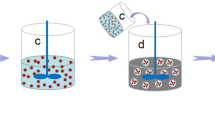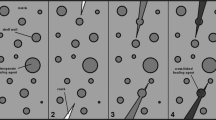Abstract
Microencapsulation is a widely used method for making healing agents used in self-healing composites. In this study, a novel two-stage process was used to make double-walled microcapsules. Dicyclopentadiene–urea formaldehyde (DCPD–UF) microcapsules were synthesized by in situ polymerization of oil-in-water emulsion followed by siloxane coating through ‘sol–gel process’ (DCPD–UF–siloxane microcapsules). Average diameter of microcapsules, UF shell thickness and siloxane coating thickness were found to be 300, 1.4 and 16 µm, respectively. The effect of addition of microcapsules on rheological properties of epoxy was studied. Breaking pattern of single-walled and double-walled microcapsules immersed in epoxy was analyzed by continuous monitoring of the deformation behavior through a rheometer–microscope arrangement, confirming improved mechanical properties of the double-walled microcapsules. In this study, epoxy resin cast specimens with and without microcapsules were prepared and the effect of microcapsules on mechanical properties was examined. Epoxy specimens with double-walled microcapsules were found to be having improved mechanical properties compared to those with single-walled microcapsules. Finally, healing efficiency of DCPD–UF–siloxane microcapsules in epoxy was observed to be marginally higher, and therefore, this double-walled microcapsule system is shown to be a promising candidate for further self-healing composite investigations.






















Similar content being viewed by others
References
White SR, Sottos NR, Geubelle PH, Moore JS, Kessler MR, Sriram SR, Brown EN, Viswanathan S (2001) Autonomic healing of polymer composites. Nature 409:794–797
Blaiszik BJ, Kramer SLB, Olugebefola SC, Moore JS, Sottos NR, White SR (2010) Self-healing polymers and composites. Annu Rev Mater Res 20:179–211
Hia IL, Vahedi V, Pasbakhsh P (2016) Self-healing polymer composites: prospects, challenges and applications. Polym Rev 56:225–261
Brown EN, Kessler MR, Sottos NR, White SR (2003) In situ poly (urea-formaldehyde) microencapsulation of dicyclopentadiene. J Microencapsul Micro Nano Carr 20:719–730
Keller MW, Sottos NR (2006) Mechanical properties of microcapsules used in a self-healing polymer. Exp Mech 46:725–733
Blaiszik BJ, Sottos NR, White SR (2008) Nanocapsules for self-healing materials. Compos Sci Technol 68:978–986
Kessler MR, Sottos NR, White SR (2003) Self-healing structural composite materials. Compos Part A 34:743–753
Leyang L, Schlangen E, Yang Z, Xing F (2016) Micromechanical properties of a new polymeric microcapsule for self-healing cementitious materials. Materials 9:1025
Chowdhury RA, Hosura MV, Nuruddin M, Narteh AT, Kumar A, Boddu V, Jeelani S (2015) Self-healing epoxy composites: preparation, characterization and healing performance. J Mater Res Technol 4:33–43
Guadagno L, Raimondo M, Vietri U, Naddeo C, Stojanovic A, Sorrentino A, Binder WH (2016) Evaluation of the mechanical properties of microcapsule-based self-healing composites. Int J Aerosp Eng 2016, 7817962
Sun D, An J, Wu G, Yang J (2015) Double-layered reactive microcapsules with excellent thermal and non-polar solvent resistance for self-healing coatings. J Mater Chem A 3:4435–4444
Caruso MM, Blaiszik BJ, Jin H, Schelkopf SR, Stradley DS, Sottos NR, White SR, Moore JS (2010) Robust, double-walled microcapsules for self-healing polymeric materials. ACS J Appl Mater Interfaces 2:1195–1199
Jin H, Mangun CL (2014) Thermally stable autonomous healing in epoxy using a dual micro-capsule system. Adv Mater 26:282–287
Mookhoek SD, Blaiszik BJ, Fischer HR, Sottos NR, White SR, Zwaag SV (2008) Peripherally decorated binary microcapsules containing two liquids. J Mater Chem 18:5390–5539
Kang S, Baginska M, White SR, Sottos NR (2015) Core–shell polymeric microcapsules with superior thermal and solvent stability. ACS Appl Mater Interfaces 7:10952–10956
Sarkar S, Kim B (2018) Facile and cost-effective synthesis of isocyanate microcapsules via polyvinyl alcohol-mediated interfacial polymerization and their application in self-healing materials. Polym Compos 39:636–644
Rzeszutko AA, Brown EN, Sottos NR (2003) Tensile properties of self-healing epoxy. In: Proceedings of fifth annual under graduate research conference in mechanics. University of Illinois, 25th April, pp 27–33
Then S, Neon GS, Abu Kais NH (2011) Performance of melamine modified urea–formaldehyde microcapsules in a dental host material. J Appl Polym Sci 122:2557–2562
Marialuigia R, Liberata G (2013) Healing efficiency of epoxy-based materials for structural applications. Polym Compos 34:1525–1532
Acknowledgements
This research work was funded by a sponsored project by Dynamics and Adaptive Structures group, STTD Division—National Aerospace Laboratories (CSIR-NAL), Bangalore, India. Characterization of samples was done at Polymer Engineering and Colloidal Science (PECS) laboratory, Department of Chemical engineering, IIT Madras, India. We acknowledge Mr. Sashikumar Ramamirtham and Ms. K. A. Ramya (IIT Madras) for their technical support in carrying out the rheometer experiments. We acknowledge Mrs. R.V Lakshmi and Mr. S. Vedaprakash (CSIR-NAL, Bangalore) for their technical contribution in siloxane coating and resin casting, respectively.
Author information
Authors and Affiliations
Corresponding author
Additional information
Publisher's Note
Springer Nature remains neutral with regard to jurisdictional claims in published maps and institutional affiliations.
Electronic supplementary material
Below is the link to the electronic supplementary material.
Rights and permissions
About this article
Cite this article
Naveen, V., Raja, S. & Deshpande, A.P. A two-step approach for synthesis, characterization and analysis of dicyclopentadiene–urea formaldehyde–siloxane-based double-walled microcapsules used in self-healing composites. Int J Plast Technol 23, 157–169 (2019). https://doi.org/10.1007/s12588-019-09247-2
Received:
Accepted:
Published:
Issue Date:
DOI: https://doi.org/10.1007/s12588-019-09247-2




